HS2 has survived a lot in the past decade, but as Jeremy Hunt prepares his Halloween Budget, some in the industry are feeling frightened. Building considers what could be at risk.
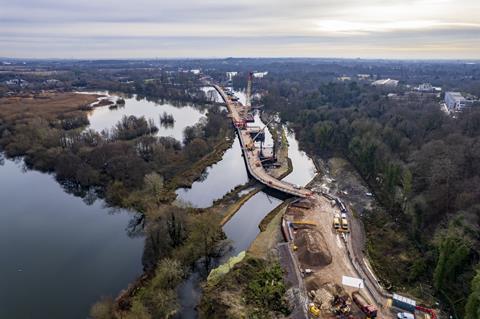
In the decade-plus since its inception, HS2 has survived successive years of austerity – despite it tripling in price – as well as multiple high court challenges and a long-running campaign of direct action against it. This week, in Rishi Sunak, it welcomes its sixth prime minister.
In light of that record of controversy, it is perhaps no surprise that the future of the project – the construction of which began in earnest just two years ago – is once again under scrutiny. To address the turmoil of the short-lived era of Trussonomics, the latest chancellor, Jeremy Hunt, says that cuts are needed and, as ever, there has been no shortage of MPs lining up to suggest that it should be HS2 that takes the hit.
>> Also read: A known quantity in uncharted waters: Rishi Sunak takes the helm in Downing Street
Six months of high, sustained inflation has done little to settle nerves and a recent HS2 board report, leaked to the Financial Times, piled further pressure on the scheme, revealing that its first phase was “very unlikely” to meet its £40.3bn target cost and that the final figure could be “many billions more than the reported estimate”.
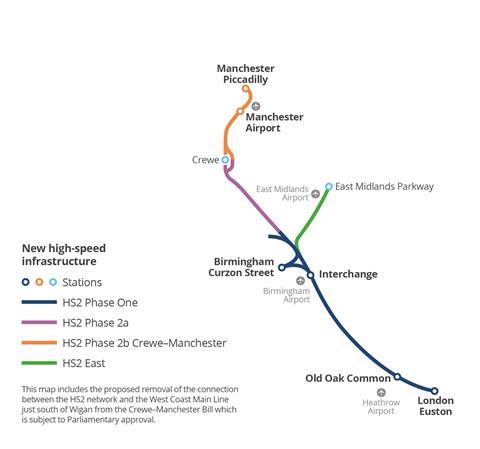
Presented by deputy chair Jon Thompson, a former head of HMRC, the report said inflation was a “significant and growing challenge” and criticised HS2’s decision to record costs at 2019 prices, as this meant none of the figures reflected “what has or is being paid”.
The Observer has reported that HS2 contractors in Birmingham say the steel they use has increased from about £800 to £1,200 a tonne and concrete from £110 to £140 a cubic metre and the board report said the project has faced “bids for money from contractors on a continual basis and significant and lengthy commercial discussions around them”.
>> Also read: Jeremy Hunt’s £40bn hole: where cuts could fall and what it could mean for builders
The amount of savings required for the Treasury to meet its goal of getting debt to fall against GDP in the medium-term will depend on forecast growth rates and borrowing costs – the IFS’s latest estimate said the chancellor needed to find £20bn by 2026/27.
The Department for Transport has insisted that it has “no plans” to cancel HS2, but according to the leaked board report, the Treasury had already asked HS2 management to identify potential cuts or “scope reductions” to the project. Hunt has been clear that he is not averse to rowing back on major investment promises.
Perhaps indicatively for high speed rail, the chancellor told parliament that he could not commit – as Liz Truss had only recently done – to building Northern Powerhouse Rail in full. Asked by Kevin Hollinrake, Tory MP for Thirsk and Malton, whether the scheme would be delivered, Hunt said that “given the severity of the situation at the moment we are not taking anything off the table”.
Industry will be only slightly reassured by his subsequent comment that long-term credible growth could not be achieved without capital spending.
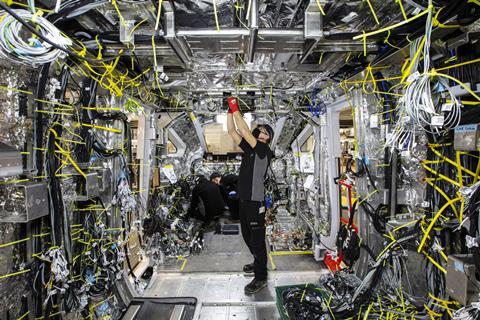
Chuck the lot
The most dramatic option for the government would be to scrap the project in its entirety, though this would be almost unthinkable given the amount of money already committed and work already completed. As of the last six-monthly update in March 2022, £14.9bn of the £44.6bn overall budget (including delegated contingency) had been spent, with an additional £12.7bn contracted but not spent.
One former senior HS2 figure told Building: “There are a lot of contracts let at the moment and, if government were minded to cancel, the repercussions on the infrastructure sector would be immense.
“Certain businesses, obviously, are highly dependent on the value flow from that programme so, in my mind, it would not be unreasonable to expect them to be compensated for that sort of decision.”
Earlier this month, Mark Thurston, HS2’s chief executive, said that the project was “well beyond the point of no return”, after the launch of two tunnel boring machines (TBMs) from Greenford in west London. Around the same time, two TBMs in the Chilterns completed the first four miles of their drive from the south portal to the second ventilation shaft at Chalfont St Giles.
If government were minded to cancel, the repercussions on the infrastructure sector would be immense
Former senior HS2 figure
Not everyone agrees, however. Lord Berkeley, who in 2020 left his role as deputy chair of the Oakervee Review into HS2 to publish a dissenting report criticising the project, claims that by re-purposing or selling the land acquired for the scheme to its original owners, almost the entirety of the cost could be recouped, with £8bn lost.
Berkeley, who claims the true cost of the full scheme is closer to £156bn, said that works already started could be re-worked to be absorbed into the existing Network Rail network and that much of the money saved could be re-invested in regional transport networks in the north of England, thereby securing the pipeline of infrastructure work.
Berkeley says that improving east-west connections and local lines would “have a much greater beneficial effect on the economy and people’s lives than going to London a bit quicker”. He added: “Doing everything at a smaller scale regionally means that the contracts are much more easily developed, let and hopefully implemented – the contracts to build HS2 are just ridiculously large, the risks are enormous.”
On this latter point he may already have been proved right. The leaked HS2 board review said two of the four consortiums hired to oversee engineering work for the first phase did not have “sufficient capacity and capability to manage all the various obligations placed upon them” and that they were “too large to effectively manage and control”.
Jason Millett, chief executive for Mace Consult, said investment into regional infrastructure “should not come at the expense of any part of the HS2 project which has already begun”, adding that “any reduction to the project will inevitably have a chilling impact on our industry”. Indeed, cancellation of phase one would at this point be an almost unimaginably bold move from the government, particularly given some of the local controversy that has surrounded parts of the project where there are already spades in the ground.
Paul Robinson, transport lead at Gleeds, which is one of HS2’s commercial partners, wondered: “How would you say that to the people around Camden who have just had the area around Euston levelled and they’ve all been re-homed – to say that you’re not going to [build] it and you’re not going to get the major investment that is going to improve where you live?”
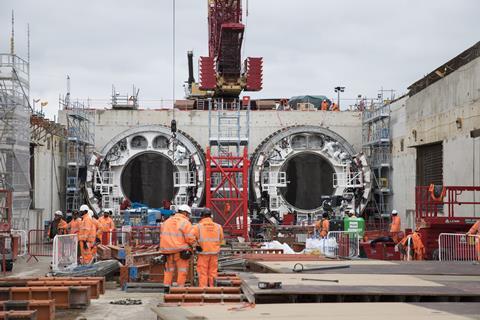
Cut it short
The other obvious options for cuts to the project would be to cancel Phase 2a (Midlands to Crewe) and 2b (Crewe to Manchester) or to change the specification of the whole scheme by reducing the planned speed and capacity. The combined cost of the second phase is estimated at up to £29.2bn (as of March), but relatively little of that has been contracted – HS2 just recently released an invitation to tender for Phase 2a design and delivery partner.
The former senior HS2 figure told Building that anything not currently committed would likely be subject to “some sort of review”, saying of the possibility of cancelling the project’s second phase: “I’m sure that’s something that somebody will be asked to look at”. Notably, the northern element of HS2 has already seen a significant reduction in scope, with the entire eastern leg to Leeds scrapped in last November’s Integrated Rail Plan.
HS2 advocates say that further reductions in scope would undermine the initial business case almost entirely. “A lot of the economic benefits come from vastly increased capacity between Manchester and London,” said Tom Wadsworth, director at High Speed Rail Group.
Gleeds’ Robinson agreed, saying: “In effect, you just created a broader community commuter belt into London, if you just got to Birmingham […] I think the worst thing they ever did was use the word ‘speed’ for the railway line, because it’s all about carbon reduction, it’s all about capacity, it’s all about economic growth across the country”.
Longevity […] allows you to focus on the skills challenge, it allows you to focus on innovation, but it’s only certainty of workload and project that allows you to do that
Paul Robinson, UK rail lead, Gleeds
According to Wadsworth, there is evidence to show that there is an outer limit to the length of train journey people will accept before opting for a flight and that therefore reducing speed would “reduce the benefits that you get in terms of climate change from dissuading people from taking unnecessary domestic flights”.
He added: “There is still a London to Manchester market, you still get people choosing to fly what is not a very long distance […] clearly providing people with a viable alternative to make those sorts of journeys is very important”.
The government will also have to consider whether it can risk jeopardising the huge number of jobs and businesses sustained by the project. There are currently more than 27,000 people employed on the scheme and more than 2,550 businesses involved. As Wadsworth points out, keeping this workforce busy is essential to delivering future major public infrastructure projects for better value.
“One of the reasons that it has been so tough and so costly to build Hinkley Point C is because we had a hiatus of 25 years without building a nuclear power station and lost all the skills on both – skills that we needed to do it,” he says. “We would be foolish to create a similar hiatus in building parts of high speed rail networks.”
Robinson agrees, adding: “The big thing with the delivery of HS2 is it gives people longevity, in terms of contractors, consultants, client bodies. Longevity and certainty of work allows people to focus on skills [and] early years apprentices because it allows you to focus on the skills challenge. It allows you to focus on innovation, and it’s only certainty of workload and project that allows you to do that.”
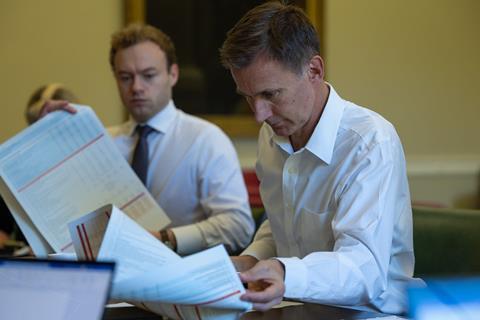
Not big enough, quick enough
Perhaps most significantly for Treasury economists, it may be hard – despite the big numbers quoted – to find significant near-term savings from the scheme. “I think it’s one of those projects where it’s very easy for people from the outside to think, Oh, that’d be a nice, easy cut,” said one industry advocate for the scheme. “[But] the amount you would save from the current budget is going to be pretty minimal.
“It’s not actually going to get you much because the costs that […] are going to affect the Budget this year and for the next three years […] things like that are already sunk cost.”
Small immediate savings could more likely be found by the chancellor by delaying the early stages of work on the later phases, but Wadsworth said this would be a false economy in the long run, as “a lot of the certainty of costs you get is from those phases when you’re working through and planning”.
A six-monthly ministerial update on the progress of HS2, due this month, has been notable for its absence and will provide a more detailed picture of how serious budget overruns on the project are. If this comes before the chancellor’s “Halloween budget” due on 31 October, it could provide a good excuse for Hunt to take a swing at the project.
On the other hand, the government may find that HS2 has become too big to fail – the economic case too reliant on its full delivery; the economy itself, and particularly the construction industry, too reliant on the jobs and income provided.
HS2 will not be completed for decades to come and inflation over such a period is almost impossible to predict – as has been shown by events of the past year. What is clear is that the more costs rise, the more entwined the prevailing government’s fate becomes with the scheme’s.
In the middle of the last Tory leadership battle, then-Cabinet Office minister Kit Malthouse described HS2 as the “killer whale” that could “rip the arm” off the next prime minister. While Malthouse has already been proven wrong on a technicality – Truss did not stick around long enough to really wrestle with the beast – the sentiment behind this prediction could yet prove to be prophetic.




























No comments yet